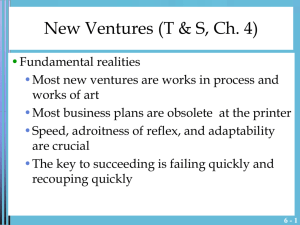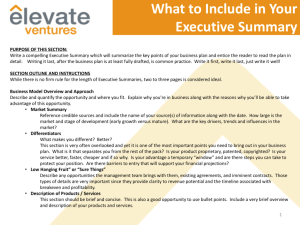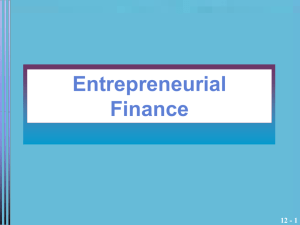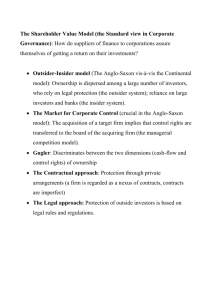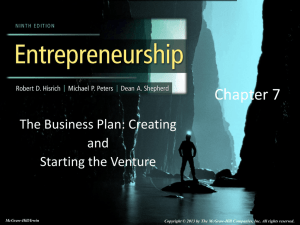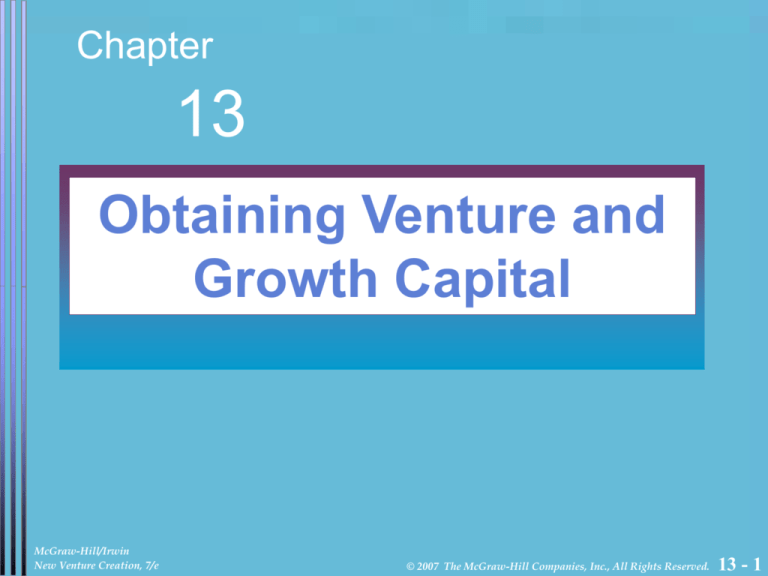
Chapter
13
Obtaining Venture and
Growth Capital
McGraw-Hill/Irwin
New Venture Creation, 7/e
© 2007 The McGraw-Hill Companies, Inc., All Rights Reserved.
13 - 1
Exhibit 13.1
13 - 2
Obtaining Risk Capital
• Three central issues to be considered
• Does the venture need outside equity capital?
• Do the founders want outside equity capital?
• Who should invest?
13 - 3
Angel Investors
• Who are angel investors?
•
•
•
•
Most are self-made entrepreneur millionaires
Many are in their 40s and 50s
Most are well educated
Ninety-five percent have college degrees from four-year
colleges
• Fifty-one percent have graduate degrees (Forty-four percent
are in a technical field and thirty-percent percent are in
business or economics)
• Ninety-six percent are men
13 - 4
Informal Investors
• What type of ventures lend themselves to the use of
informal investors?
• Ventures with capital requirements of between $50,000 and
$500,000
• Ventures with sales potential of between $2 million and $20
million within 5 to 10 years
• Small, established, privately held ventures with sales and
profit growth of 10% to 20% per year
13 - 5
Informal Investors
• What type of ventures lends themselves to the use of
informal investors?
• Special situations, such as very early financing of hightechnology inventors who have not developed a prototype
• Companies that project high levels of free cash flow within
three to five years
13 - 6
Exhibit 13.3
13 - 7
Exhibit 13.6
13 - 8
Exhibit 13.8
13 - 9
Exhibit 13.9
13 - 10
What to Look for in Investors
• Seek investors who:
• Are considering new financing proposals and can provide the
required level of capital
• Are interested in companies at the particular stage of growth
• Understand and have a preference for investments in the
particular industry
13 - 11
What to Look for in Investors
• Seek investors who:
• Can provide good business advice, moral support, and has
contacts in the business and financial community
• Are reputable, fair, and ethical and with whom the
entrepreneur gets along
• Have successful track records of 10 years or more advising
and building smaller companies
13 - 12
What to Look Out for in Investors
• Attitude
• Be wary if getting through to a general partner in the
investment firm is an ordeal
• Be wary if the investor thinks he or she can run the
business better than the lead entrepreneur or the
management team
• Over commitment
• Be wary of lead investors who indicate they will be active
directors but who also sit on the boards of six to eight other
startup and early0stage companies or are in the midst of
raising money for a new fund
13 - 13
What to Look Out for in Investors
• Inexperience
• Be wary of dealing with venture capitalists who are under 30
years of age and have:
• An MBA
• Only worked on Wall Street or as a consultant
• No operating, hands-on experience in new and growing
companies
• A predominantly financial focus
13 - 14
What to Look Out for in Investors
• Unfavorable reputation
• Be wary of funds that have a reputation for early and
frequent replacement of the founders
• Be wary of those where more than one-fourth or the
portfolio companies are in trouble or failing to meet
projections in their business plans
• Predatory pricing
• Be wary of investors who unduly exploit conditions during
adverse capital markets by forcing large share price
decreases in the new firms and punishing terms on prior
investors
13 - 15
Presenting Information to Possible
Investors
• A concise presentation should include the following:
•
•
•
•
•
What is the market opportunity?
Why is it compelling?
How will/does the business make money?
Why is this the right team at the right time?
How does an investor exit the investment?
13 - 16
Chapter
14
The Deal: Valuation,
Structure, and
Negotiation
McGraw-Hill/Irwin
New Venture Creation, 7/e
13 - 17
© 2007 The McGraw-Hill Companies, Inc., All Rights Reserved.
Exhibit 14.1
13 - 18
Exhibit 14.3
13 - 19
Exhibit 14.5
13 - 20
Valuation Methods
• The Venture Capital Method
• Appropriate for investments in a company with negative
cash flow at the time of the investment, but which in a
number of years is projected to generate significant earnings
• The Fundamental Method
• Simply the present value of the future earnings stream
13 - 21
Valuation Methods
• The First Chicago Method
• Employs a lower discount rate, but applies it to an expected
cash flow
• Discounted Cash Flow
• Three time periods are defined (1) Years 1-5, (2) Years 6-10,
(3) Year 11 to infinity
• Operating assumptions include initial sales, growth rates,
EBIAT/sales, and (net fixed assets + operating working
capital)/sales; also note relationships and trade-offs
13 - 22
What is a Deal in Entrepreneurial
Finance?
• Deals—economic agreements between at least two parties
that involves the allocation of cash flow streams (with
respect to both amount and timing), the allocation of risk,
and hence the allocation of value between different groups
13 - 23
Deal Characteristics
• Characteristics of successful deals
•
•
•
•
They are simple
They are robust
They are organic
They take into account the incentives of each party to the deal
under a variety of circumstances
• They provide mechanisms for communications and
interpretation
13 - 24
Deal Characteristics
• Characteristics of successful deals
•
•
•
•
They are based primarily on trust rather than on legalese
They are not patently unfair
They do not make it too difficult to raise additional capital
They match the needs of the user of capital with the needs of
the supplier
• They reveal information about each party
13 - 25
Deal Characteristics
• Characteristics of successful deals
• They allow for the arrival of new information before
financing is required
• They do not preserve discontinuities
• They consider the fact that it takes time to raise money
• They improve the chances of success for the venture
13 - 26
Minimizing Surprises
• Tips to consider when raising capital:
• Raise money when you do not need it
• Learn as much about the process and how to manage it as you
can
• Know your relative bargaining position
• If all you get is money, you are not getting much
• Assume the deal will never close
• Always have a backup source of capital
• The legal and other experts can blow it -- sweat the details
yourself
13 - 27
Negotiation
• Steps of principled negotiation
•
•
•
•
Separate the people from the problem
Focus on interests, not positions
Generate a variety of possibilities before deciding what to do
Insist that the result be based on some objective standard
13 - 28
Burdensome Issues for Entrepreneurs
•
•
•
•
•
•
•
Co-sale provisions
Ratchet anti-dilution protection
Washout financing
Forced buyout
Demand registration rights
Piggyback registration rights
Key-person insurance
13 - 29
Kawasaki, Chapter 3
• The Art of Pitching
• You have one minute
• Don’t make it overly autobiographical
• Answer the unspoken questions from the “little man” by
using the “For instance…” statements
• Not everyone will be shocked, awed or inspired
• So…
13 - 30
Kawasaki, Chapter 3
• The Art of Pitching
• Decide what is MOST important about:
•
•
•
•
Your idea
The business model
Most likely questions to be answered
You
13 - 31
Kawasaki, Chapter 3
• The Art of Pitching
• Know your audience
• 10/20/30 or 10 slides, twenty minutes, thirty-point font
• Excuse me, thirty-point font
• Slides should contain talking points not text
13 - 32
Kawasaki, Chapter 3
• The Art of Pitching
• Remember, you only want to spark interest, this
isn’t the making or closing of a deal
13 - 33
Kawasaki, Chapter 3
• The Art of Pitching
• CEO/Founder should do the talking
• Team management during presentation (no
interrupting)
13 - 34
Kawasaki, Chapter 3
• The Art of Pitching
• Focus on your total addressable market (TAM)
• Just enough detail…not too much, not too little
• Take notes
13 - 35

